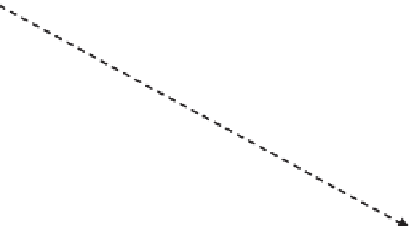Geoscience Reference
In-Depth Information
The UTM projection is such that at scales smaller than
1:250,000 significant distorsions can occur. Also, if the zone
of interest straddles two UTM zones, then the conversion from
one zone to the next is not straightforward. This is significant
because, occasionally, a local triangulation (survey) point may
be assigned a UTM coordinate that has not been corrected for
geometric distortion. Mining companies will generally define
local grids based on truncated UTM coordinates, which, al-
though sometimes suffering from geometric distorsion, have
little impact on relative positions at the mining project scale.
Another common practice in geology and mining is to
use local, arbitrary “mine” grids to more easily character-
ize the geometry of the ore deposit. Many ore deposits have
principal features aligned in directions other than the Easting
and Northing of the UTM coordinates. Common examples
of this include vein-type deposits, and deposits where the
mineralization is structurally or shear-hosted, or otherwise
controlled by elongated features. One specific case study can
be found in Barnes (
1982
).
The drill hole information and the corresponding geologi-
cal cross sections used to model the deposit should be per-
pendicular to the main directions of mineralization (strike
and dip). The more anisotropic the geometry of the deposit,
the more important this aspect becomes. In these situations
it is common to rotate the coordinates to align the mine grid
north with the main strike or dip direction. Additionally, the
conversion often includes a translation to an arbitrary origin,
selected such that (a) the Easting, Northing, and Elevation
coordinates have different number of digits to avoid confu-
sion and (b) there are no negative coordinates in the new,
rotated grid.
The rotations can be done using any convention desired.
For example, and using the GSLIB convention (Deutsch and
Journel
1997
), the first initial clockwise rotation of the origi-
Y
Y'
α
+
y
1
y
0
α
y
0
cos
α
α
x
0
sin
α
x
0
cos
α
X
x
0
y
0
sin
α
Z
x
1
X'
Fig. 3.14
Azimuth rotation on the X-Y plane around the Z axis, GSLIB
convention
The third rotation of the (x
2
; y
2
; z
2
) coordinates of a plunge
angle
φ
is counter-clockwise on the X'-Z' plane around the
Y' axis:
x
cos 0 sin
0 10
sin
ϕ
ϕ
x
3
2
y
=
⋅
y
3
2
z
−
ϕ
0
cos
ϕ
z
3
2
The three-step rotation described can be summarized in a
single step:
x
cos
αϕαβϕ αϕαβϕ βϕ
αβ αβ β
αϕαβϕ αϕαβϕ βϕ
cos
−
sin
sin
sin
−
sin
cos
−
cos
sin
sin
cos
sin
x
3
0
y
=
sin
cos
cos
cos
sin
⋅
y
3
0
z
−
cos
sin
−
sin
sin
cos
sin
sin
−
cos
sin
cos
cos
cos
z
3
0
nal (x
0
; y
0
; z
0
) coordinates by an azimuth angle
α
can be writ-
ten as, see Fig.
3.14
:
At any stage of the rotation, a translation may be applied, as
needed. For example, translating the (X, Y) coordinates of
the origin of the model can be represented according to the
equations shown below and Fig.
3.15
:
x
cos
α
−
sin
α
0
x
1
0
y
=
sin
α
cos
α
0
⋅
y
1
0
o
x xx
y yy
zz
'
'
'
=+
=+
=
z
0
0
1
z
1
0
o
Following the GSLIB convention, the new (x
1
; y
1
; z
1
) can
then be rotated a dip angle
β
counter-clockwise on the Y'-Z
plane around the X' axis:
3.4.2
Stratigraphic Coordinates
x
1
0
0
x
Specific non-linear transformations are sometimes used
to better model certain types of deposits. The use of
stratigraphic coordinates is convenient in the cases of sedi-
2
1
y
=
0
cos
β
sin
β
⋅
y
2
1


















